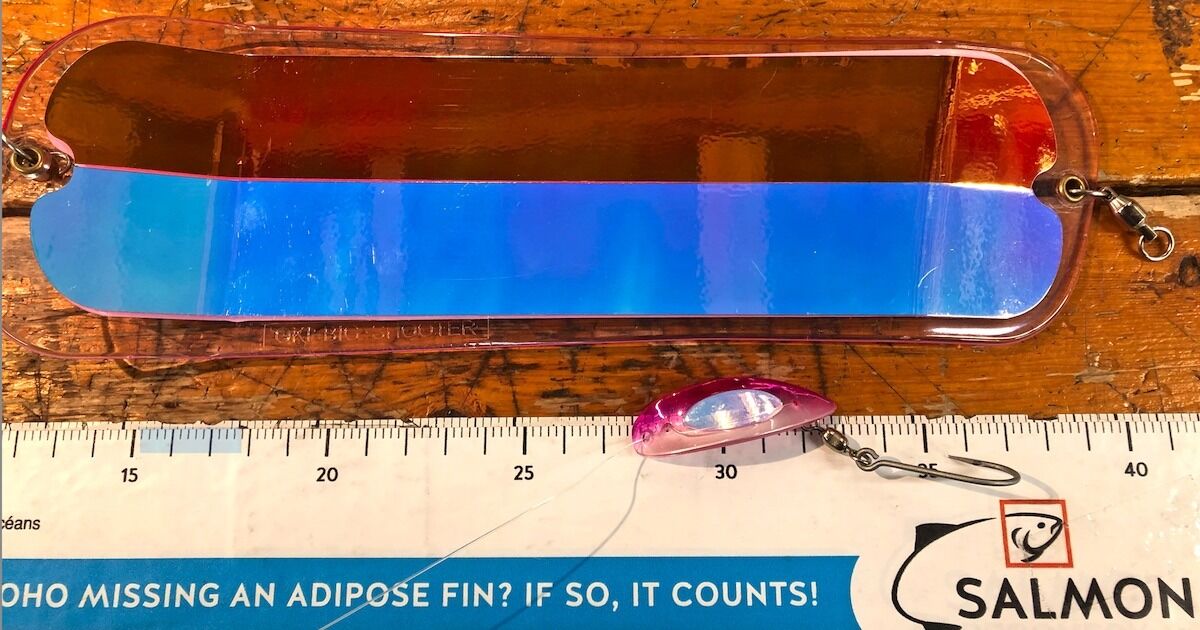
Choosing the right leader sounds like a simple task. But, as with most fishing related topics, there are many variables, not to mention different views on the subject. However, you can apply a few basic rules of thumb when choosing your leader.
First learn the basics, and then you can start experimenting. Or, just stick to these tried-and-true methods, and spend your time catching fish instead.
What is a Fishing Line Leader?
A leader is the length of line that is connected to one’s lure. For salmon trolling, it typically is the line between the flasher and the lure. It can also refer to the length of monofilament used between braided line and the lure.
For salmon trolling, your leader length will vary more based on the type of lure you are using than the type of salmon you are targeting. While there is some variation depending on size, species, and time of year, the basic rules apply to most situations.
Fishing Leader Length Table
Leaders for Trolling Spoons & Bait in Teaser Heads
A long leader is required when trolling spoons and teaser-head-rigged anchovies. Both lures have their own built-in action, so having them too close to the flasher will affect this action. The leader line should be about the same pound test as the main line. Going with too stiff or too heavy line will dampen down the lure’s inherent action. A standard leader is 6′ for spoons and maybe a bit longer for anchovies. Most fishermen I know find 30-lb is the right balance of strength and flexibility.
Fishing Leader Length—Spoons 6ft
Leaders for Trolling Octopus or Needlefish Hoochies
Trolling octopus or needlefish hoochies are the opposite. They have no action of their own, and derive all their movement from the flasher itself. They therefore must be relatively close to the flasher. The leader should be a heavier test to whip them around. A light, limp leader will not impart the flasher’s action to the hoochie. A standard leader for regular hoochies is 36″ of 40- to 50-lb test line.
Fishing Leader Length—Octopus 3ft
Fishing Leader Length—Needlefish 3ft
Trolling squirt (small) hoochies is an exception to the above rule. They must be on a much shorter leader when targeting sockeye or pink salmon. They should be around 20″ long; sometimes they can be a bit shorter or longer depending on the response of the fish. Some fishermen swear that only an 18″ leader will do, and some say 24″. So, this is one area where a bit of experimentation may be in order.
Fishing Leader Length—Squirt 20 inches
Leaders for Bottom Fish
Leaders for bottom fish differ in that they must be much heavier to deal with the sharp teeth of halibut and lingcod. Trolling for both species is very effective, and standard leader lengths for spoons and hoochies will work. Using 100-lb test will provide the abrasion resistance needed to handle these fish. Also, since you’ll be using larger lures, heavier line will help transmit the flasher action to a large hoochie or baitfish.
Easy Trick to Measure Your Leader
A simple trick to measure your leader for the average-sized person is to measure by your own “wingspan”—the distance between your fingertips, with arms fully extended. This likely will be around 6′. Simply grab your line and measure out the distance from one extended hand to the other, cut the line, and tie it to the spoon. For most octopus or needlefish hoochies, do the same, but only measure from your fully extended hand to the tip of your nose. This should give you about three feet. While not precise, this trick allows you to measure out a fresh leader quickly. Regularly changing leaders is as important as sharpening your hook, and this quick method allows you to have a fresh leader always ready to go. Your fishing line is one of the cheapest—but most important—items in your tackle box. Run your fingers along the leader frequently. If you feel any nicks, abrasions or anything other than smooth line, cut and change the leader. It is also wise to change your leader proactively after a big fish, long fight, or snagging the bottom. Be extra careful to check your line after catching a dogfish. Their rough sharkskin can damage leaders, and they are infamous for doing the “dogfish roll,” where they twist and wrap themselves up in the fishing line. So, when in doubt, change your leader out.
Leader Type
Which type of line to use for which leader is a whole other topic of discussion, but here are a few ideas as a starting point. When abrasion or stiffness is required, use fluorocarbon. For example, stiffness is desired for whipping hoochies around. When elasticity or limpness is needed, such as when one wants a light spoon to be able to swim freely and have the most action, normal monofilament is best. For protection from bottom fishes’ teeth, fluorocarbon or very heavy monofilament is best.
Choosing the right leader length is very important for getting the most out of the lure you are using. Following these basic rules should simplify this aspect of fishing. While there will always be exceptions to these rules, hopefully this information gives you a solid foundation.
This article appeared in Island Fisherman magazine. Never miss another issue—subscribe today!
One Comment
Leave A Comment
Visit the Store
$34.99
$34.99
Featured Catch
Joel Unickow halibut (Photo: Rob Frawley Lucky Strike Sportfishing Tofino)





Great article wioth good information for trolling.